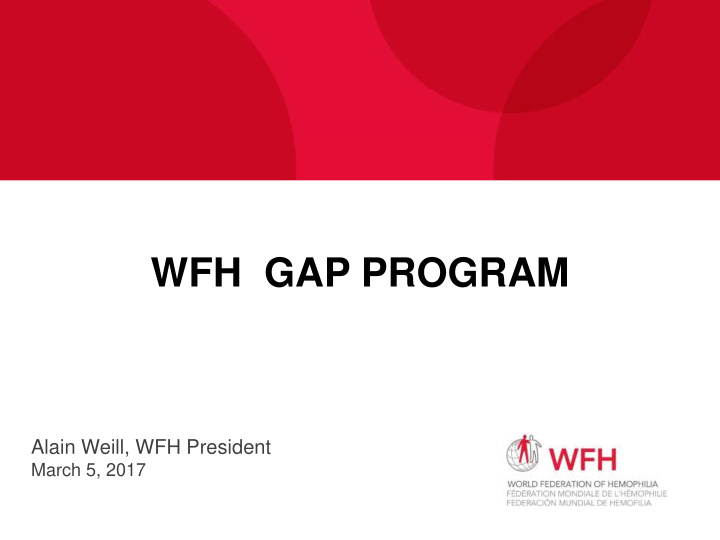



WFH GAP PROGRAM Alain Weill, WFH President March 5, 2017
GLOB A L A LLIA N C E FOR PR OGR ESS ( G A P) PR OGR A M • Flagship WFH healthcare development project • Launched in 2003 • Foster partnership between government, healthcare providers and patients • Develop sustainable national care programs • Multi-sponsored program 2
GA P: 10 YEA R STR ATEG IC GOA LS ( 2013 - 2022) Second Decade of GAP Identifying an additional 50,000 people with inherited bleeding disorders by 2022, with 50% of them living in the world’s poorest regions Results to date • 30,296 have been identified globally • Including 6,852 from the poorest countries 3
GA P SEC ON D D EC A D E: C OMPON EN TS TIER 1 TIER 2 TIER 3 CONTINUE ADVANCE ASSIST SUCCESSFUL ACHIEVEMENTS COUNTRIES WITH STRATEGY OF GAP POST GAP MID-LEVEL TREATMENT 4
GA P SEC ON D D EC A D E: C OMPON EN TS I. Full-GAP Program : Continuation of current GAP working on all 6 pillars of WFH Development Steps Model II. Post-GAP Program : Post-GAP countries which would benefit from additional support in advancing a National Country Program, building up on GAP Phase 1 achievements or improving sustainability of Phase 1 III. Mid-Level GAP Program : Intermediate level countries which need help in moving forward to the next level of care 5
W FH D EVELOPMEN T MOD EL A step-by-step process to reach sustainable care across six distinct but interrelated pillars Improve medical Build a strong expertise and Achieve Increase Track national national increase government access to demographic Improve care patient accurate support safe data delivery organization laboratory treatment through through diagnosis advocacy products capacity through training 6
GA P PA R TIC IPATIN G C OU N TR IES: 2003 - 2 0 1 6 Russia Belarus Serbia Georgia China Moldova Azerbaijan Jordan Armenia Tunisia Vietnam Lebanon Turkey Mexico Honduras Morocco Thailand Egypt Philippines Syria Colombia Algeria Ecuador Peru Brazil South Africa TOTAL: 26 countries / 31 programs 7
GA P OVER A LL A C H IEVEMEN TS: 2003 - 2 0 1 6 81,212 new PWH diagnosed/registered globally (end 2015) 26 countries enrolled; 31 multi-year national bleeding disorder care development plans drawn up 19 GAP MoU signed 29,247 PWH / 4,824 VWD / 3,160 RBD diagnosed in GAP countries 16,449 new patients, family members, and (NMO) board members trained / 23,366 medical professionals trained Treatment product access: Over 4.642 billion IUs purchased 8
GA P A C H IEVEMEN TS: JA N U A RY - D EC EMB ER 2016 Overall 12 active countries / closing of GAP South Africa and GAP Moldova (end 2015) Results 4 new GAP countries in 2016: Vietnam (T1), China (T2), Morocco (T2), and Turkey (T3) 2 GAP MoUs signed (Jordan, Vietnam) and continued discussions and negotiations on other MoUs (Honduras, Serbia) Continued collaboration following signed MoUs (Algeria, Colombia, Egypt and Morocco) 462 new patients with hemophilia, 157 with VWD, 134 with rare clotting factor deficiencies diagnosed / registered in GAP countries Over 710 million IUs increase in product supply 9
2017 GA P C OU N TRY PR OGR A MS Europe • Serbia • Turkey Asia Americas • • China Colombia • • Middle East Vietnam Honduras • • • Malaysia (NEW Brazil Egypt • Tier 3) Uruguay (NEW Tier 3) • Jordan • Morocco • Tunisia (NEW Tier 2) TOTAL: 13 10
GA P VIETN A M ( TIER 1 – FU LL - GA P PR OGR A M) • Population (2014): 93,421,835 • GNI per capita (2015): 1,980 (US$) • Public Health expenditure,(% of GDP) (2014): 3.8 • Expected number of people with hemophilia / prevalence: 6,213 • Confirmed number of people with hemophilia (2014): 2,373 • Factor VIII usage (2014): 0.099 IU per capita *Population, Confirmed number of PWH & Factor VIII usage : Global Survey 2014 *GNI per capita & Public Health expenditure: World Bank 11
G A P M O U S I G N I N G C E R E M O N Y: S E P T E M B E R 2 1 , 2 0 1 6 12
GA P PLA N N IN G VISIT – FEB R U A RY 13 - 14, 2017 During February 13-14, 2017, a visit was organized in Vietnam to develop a detailed action plan for the GAP Program. 13
VIETN A M D EVELOPMEN T PLA N : MA IN OB JEC TIVES Government Strengthening exiting Development of support for a network of 7 medical expertise of hemophilia treatment national hemophilia HCPs in selected 7 centres care program HTCs Increase the supply Expand NMO and of factor concentrates Support development increase its lay and increase factor and implementation a leadership and number concentrates access national registry of active volunteers for patients 14
SU PPOR T TO VIETN A M TH R OU GH OTH ER PR OGR A MS Hanoi (NIHBT) – Melbourne (Alfred Vietnam – Ireland HOT Twinning Hospital) HTC Twinning Program Program, 2011-2014 2011-2014 Participation in the WFH Global WFH Humanitarian Aid Program NMO Training, international donations (3 M ius in 2016) meetings, and congresses Improve laboratory diagnosis standards Training of healthcare professionals through participation in IEQAS through WFH IHTC Fellowship Program Participation in the ASEAN Hemophilia Network meetings/ workshops 15
THANK YOU
Recommend
More recommend